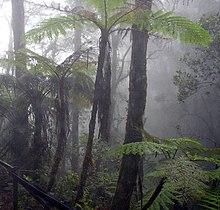humidity

The term moisture or humidity indicates the extent to which water is present in or on a material (e.g. textiles) or a substance or in a gas or in a room (e.g. in the basement of a building ). Strong moisture is also known as wetness .
In physics and materials science, one generally speaks of water content . However, moisture or humidity can sometimes also be understood as the content of other liquids , for example benzene .
The removal of water from a surface or from a substance is generally referred to as drying or drainage .
meaning
The water content of air is generally referred to as humidity . The absolute humidity indicates how much water vapor is contained in the volume unit of the gas mixture; Unit of measurement: g water · m −3 . The relative humidity is the quotient of the amount of water vapor present in the gas at a certain temperature and the saturation amount of water vapor possible at the same temperature. The relative humidity is usually given in percent (%). To do this, the quotient is multiplied by 100. Is the air saturated, i.e. H. the relative humidity is 100%, some of the water in the air is liquid. In this case, the associated liquid-gas mixture is referred to as haze or mist .
The moisture in the soil is referred to as soil moisture , that of the rock as pore water , that of the skin as skin moisture and that of wood as wood moisture . Moisture in construction see moisture damage and water damage .
The moisture of a substance is linked to many properties. Examples of this are shrinkage and swelling (change in dimensions ) when water is absorbed and released, resistance to swelling , electrical conductivity , thermal conductivity , the coefficient of friction , and the formation of mold .
Moisture in building components
Capillary-porous building materials store water with the origin:
- Residual moisture after the setting process
- penetrated precipitation
- water vapor diffused in, often supported by hygroscopic wall salts
- rising damp after transport through the capillaries
- Condensation education, for example, on the outside of thermal insulation ( dew precipitation) to cool cellar interior walls during the summer or during the sooting of chimneys
Moisture spreads through seepage or vapor diffusion or often by capillary action at horizontal expansion joints (as structural damage) or cracks in the plaster. In this way, moisture can penetrate into what are actually rain-proof composite thermal insulation systems and wet the components. Black mold and algae find good growth conditions on damp components in connection with organic nutrients from binding agents, paint coatings, wallpaper adhesives, paper wallpaper or wood .
Analytical determination
Infrared moisture meters are usually used to quickly determine the moisture content of a substance sample. These devices are both dryers and scales . Infrared radiators are used as a heat source. The infrared radiation penetrates more than 1 cm deep into the substance to be dried, at the same time the light energy is converted into heat energy. The moisture content is determined from a sample weight on one and the same weighing plate, the change in weight (cause: loss of moisture) is transferred to a display scale and displayed directly in percent (%) moisture.
A quantitative determination of the water content of samples can also be carried out titrimetrically using the Karl Fischer method .
In industry and for leak detection in buildings, capacitive moisture measurement is also widespread. Changes in the relative permittivity caused by moisture are measured by using a spherical electrode to determine comparative values at dry and damp areas. The measuring depth varies between 40 mm and 100 mm, depending on the type of material and layer thickness, whereby the material is not damaged.
Web links
Individual evidence
- ↑ a b Brockhaus ABC Chemie , VEB FA Brockhaus Verlag Leipzig 1965, pp. 408-409.
- ↑ Otto-Albrecht Neumüller (Ed.): Römpps Chemie-Lexikon. Volume 2: Cm-G. 8th revised and expanded edition. Franckh'sche Verlagshandlung, Stuttgart 1981, ISBN 3-440-04512-9 , pp. 1275-1276.
- ^ Brockhaus ABC Chemie , VEB FA Brockhaus Verlag Leipzig 1965, p. 1441.
- ↑ The basement waterproofing, the drying of the walls and the causes of damp basements .
- ^ Walter Wittenberger: Chemische Laboratoriumstechnik , Springer-Verlag, Vienna, New York, 7th edition, 1973, p. 139, ISBN 3-211-81116-8 .

